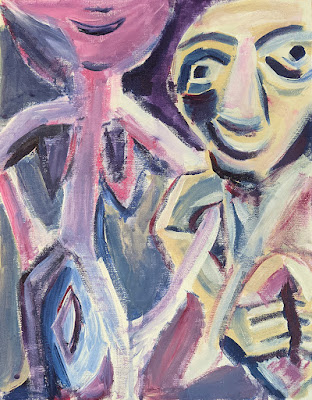The Guardian published a piece on Sheela Na Gigs for International Women's Day on Monday. Here's a link. A few weeks ago, I painted two Sheelas.
Found on churches throughout the British Isles and Europe, Sheela Na Gigs are "figurative carvings of naked women displaying an exaggerated vulva." There are over 100 documented examples just in Ireland. The carvings may be remnants of a pre-Christian mother goddess. They may also have been thought to ward off evil spirits. They're often found over doors or windows, and they're generally smiling.
The two I have painted are from the Church of St. Mary and St. David at Kilpeck, Herefordshire, England and the Parish Church of Oaksey, Wiltshire.
While I was researching the Sheelas I came across other related stories of, as the Guardian so deftly put it, "big vagina energy". The power of women (especially the nude form) to create life, protect it, or - conversely - take it away.
My favorite was the story of a group of women in Nigeria in 2002 who successfully won concessions from Chevron Oil using nothing but the threat of big vagina energy.
On July 8, 2002, 600 Niger Delta women took over the largest oil production facility in Nigeria. For ten days, unarmed, they stopped the production of 500,000 barrels of oil per day from Chevron, one of the wealthiest and most powerful corporations in the world, by threatening to strip naked in public. Mothers stripping naked is a powerful curse in Nigeria. The security forces refused to touch the women.According to anthropologist Terisa Turner, "We come into the world through the vagina. By exposing the vagina, the women are saying: 'We are hereby taking back the life we gave you.' It's about bringing forth life and denying life through social ostracism, which is a kind of social execution. Men who are exposed are viewed as dead. No one will cook for them, marry them, enter into any kind of contract with them or buy anything from them."
 The women's threat was successful. After ten days they won an agreement from Chevron to hire villagers and to build schools and water systems.
The women's threat was successful. After ten days they won an agreement from Chevron to hire villagers and to build schools and water systems.



I wrote a Sheela Na Gig post after the Portland woman spread her legs against the line of police during the protests last summer; I couldn't help but see a parallel. https://www.newenglandbard.com/post/the-protester-and-the-power-of-ancient-ireland
ReplyDeleteYes! I planned on painting her as part of a series, but I got distracted. Total parallel.
DeleteGreat blog post! I love that you interviewed an expert. I should someday try that. Thanks for the idea.
Delete